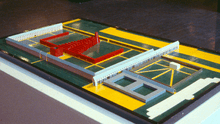Aldo Rossi
| Aldo Rossi | |
|---|---|
 (ca. 1986-87) | |
| Born |
3 May 1931 Milan, Italy |
| Died |
4 September 1997 (aged 66) Milan, Italy |
| Nationality | Italian |
| Alma mater | Politecnico di Milano |
| Occupation | Architect |
| Awards | Pritzker Prize (1990) |
| Buildings | Teatro Carlo Felice |
Aldo Rossi (3 May 1931 – 4 September 1997) was an Italian architect and designer who accomplished the unusual feat of achieving international recognition in four distinct areas: theory, drawing, architecture and product design.[1]
Biographical notes
Rossi was born in Milan, Italy. In 1949 he started studying architecture at the Politecnico di Milano where he graduated in 1959. Already in 1955 he started writing for the Casabella magazine, where he became editor between 1959–1964.
Aldo Rossi died in a car accident in September 1997 in Milan.
Work
.png)

His earliest works of the 1960s were mostly theoretical and displayed a simultaneous influence of 1920s Italian modernism (see Giuseppe Terragni), classicist influences of Viennese architect Adolf Loos, and the reflections of the painter Giorgio de Chirico. A trip to the Soviet Union to study Stalinist architecture also left a marked impression.
In his writings Rossi criticized the lack of understanding of the city in current architectural practice. He argued that a city must be studied and valued as something constructed over time; of particular interest are urban artifacts that withstand the passage of time. Rossi held that the city remembers its past (our "collective memory"), and that we use that memory through monuments; that is, monuments give structure to the city.

He became extremely influential in the late 1970s and 1980s as his body of built work expanded and for his theories promoted in his books The Architecture of the City (L'architettura della città, 1966) and A Scientific Autobiography (Autobiografia scientifica, 1981).The largest of Rossi's projects in terms of scale was the San Cataldo Cemetery, in Modena, Italy, which began in 1971 but is yet to be completed. Rossi referred to it as a "city of the dead".
The distinctive independence of his buildings is reflected in the micro-architectures of the products designed by Rossi.[2] In the 1980s Rossi designed stainless steel cafetières and other products for Alessi, Pirelli, and others.

Exhibits
For the Venice Biennale in 1979 Rossi designed a floating Teatro del Mondo[3] that seated 250 people. For the Venice Biennale in 1984, he designed a triumphal arch at the entrance to the exhibition site. In 2006 two pylons based on an original 1989 design by Aldo Rossi were erected in front of the Bonnefanten Museum in Maastricht by the Delft architectural firm Ufo Architecten.
Awards
Aldo Rossi won the prestigious Pritzker Prize for architecture in 1990. Ada Louise Huxtable, architectural critic and Pritzker juror, has described Rossi as "a poet who happens to be an architect."
Architecture
- Monte Amiata complex in the Gallaratese district of Milan, Italy (1968–1974) with Carlo Aymonino[4]
- San Cataldo Cemetery, Modena, Italy (1971-)[5]
- Teatro del Mondo, Biennale di Venezia (1979) Disegni e foto
- Apartments Südliche Friedrichstadt for the IBA 84 exhibition at Berlin (1979)
- Broni elementary school, with Arduino Cantafora
- Teatro Carlo Felice in Genoa, Italy (1981)
- Centro direzionale, Perugia, Italy (1982–88)
- Palazzo Hotel in Fukuoka, Japan (1986–89)
- Bonnefanten Museum, Maastricht, The Netherlands (1990–94)
- Quartier Schützenstrasse in Berlin, Germany (1994–98) Photos[6]
- Ca' di Cozzi in Verona, Italy, his last project[7]
- Mojiko Hotel, KitaKyushu, Japan (1996–98)
- Scholastic Corporation Headquarters, New York City, USA (2001, posthumous)
-
Teatro Carlo Felice, Genoa (1981)
-

Bonnefanten Museum, Maastricht (1990–94)
-

Quartier Schützenstrasse, Berlin (1994–98)
-

Mojiko Hotel, Japan (1996–98)
-
Scholastic Building, New York City (2001)
References
- ↑ Celant, Germano & Ghirardo, Diane (2008). Aldo Rossi: Drawings. Milan: Skira. ISBN 978-88-6130-143-6.
- ↑ Buerdek, Bernhard E. (2005). Design: History, theory and practice of product design. Basel, Switzerland: Birkhauser-Publishers for Architecture. ISBN 978-3-764-37029-9.
- ↑ http://archidose.blogspot.com/1999/02/teatro-del-mondo.html
- ↑ http://carbon.cudenver.edu/%7Earc67015/aal-fara/Synopsis.html
- ↑ http://www.significantcemeteries.net/significant/modena/Intro.html
- ↑ http://www.arcspace.com/architects/Rossi/schutzenstrasse.html
- ↑ http://www.designboom.com/eng/exhibition/rossi1.html
Further reading
- Pangalos, Panayotis (2008). The significance of time in contemporary architecture. Technical and poetic time: the case of Aldo Rossi. Phd dissertation. University of Patras, Greece.
- Arnell, Peter & Bickford, Ted (1985). Aldo Rossi. Buildings and Projects. New York: Rizzoli. ISBN 0-8478-0499-2.
- Berlucchi, Nicola (2000). "Aldo Rossi: ricostruzione del teatro La Fenice". Area (in Italian) 51.
- Ferlenga, Alberto (1996). Aldo Rossi. Opera completa (1993–1996) (in Italian). Milan: Electa. ISBN 88-435-5543-X.
- Leoni, G. (a cura di) (1997). "Costruire sul costruito, intervista a Aldo Rossi". Area (in Italian) 32: 44–47.
- Polazzi, Giovanni (1999). "Aldo Rossi Associati - Area ex mattatoio". Area (in Italian) 46: 106–110.
External links
| Wikimedia Commons has media related to Aldo Rossi. |
- Pritzker Prize web page on Rossi.
- Bonnefanten Museum on Aldo Rossi
- Aldo Rossi archive at the Canadian Centre for Architecture
- Aldo Rossi Foundation
| ||||||
|

